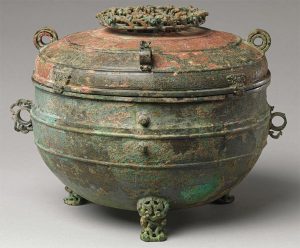The National Museum of Asian Art’s scientific efforts are aided by the Edward Waldo Forbes Fund. It has promoted the study of the care, conservation, and preservation of works of art through the Forbes Symposium, fellowships, lectures on the technical study of works of art, and collaborative efforts in research and conservation with other institutions since 1986.
Edward Waldo Forbes Fund


Forbes Symposia and Lectures on Scientific Research in the Field of Asian Art
Scientific Research in the Field of Asian Art is a series of symposia to highlight recent scientific and technical studies of the arts of Asia. In addition to serving as a means for disseminating research results, the symposia provide a forum for discussion and interaction among an international group of researchers.
The first Forbes Symposium was held in 2001, on the fiftieth anniversary of the Freer Gallery’s initial pursuit of scientific endeavors, to survey the state of scientific research in Asian art. Subsequent symposia have focused on such topics as the pictorial and sculptural arts of Asia and historic Asian ceramics. Links to proceedings that are available for purchase are listed below.
The series is supported by the Edward W. Forbes Fund. This bequest to the Freer Gallery was made by John Thacher in honor of his former colleague, Edward Waldo Forbes, a past director of the Fogg Art Museum at Harvard University and an early proponent of applying technical examination to the study of art.
Papers presented at the symposia are available as a series of volumes. The below list includes links to details about proceedings that are currently available to order online. For questions, please call 202.633.0385.
- Scientific Research on Early Chinese Lacquer Buddhas (2018)
- Scientific Research on Ancient Asian Metallurgy (2012)
- Scientific Research on Historic Asian Ceramics (2009)
- Scientific Research on the Sculptural Arts of Asia (2007)
- Scientific Research on the Pictorial Arts of Asia (2005)
- Scientific Research in the Field of Asian Art (2003)
Forbes Workshops and Lectures
January 15, 2015. Debating the use of lost-wax casting in China. Donna Strahan, National Museum of Asian Art
 “Debating the use of lost-wax casting in Ancient China” is the written version of the January 15, 2015 Forbes Lecture on Scientific Research in the Field of Asian Art given at the Freer Gallery of Art by Donna Strahan, the Head of the Department of Conservation and Scientific Research of the Freer Gallery of Art and Arthur M. Sackler Gallery. The paper discusses theories and evidence on the use of lost-wax versus piece-mold casting for bronze production in ancient China, focusing on four case studies.
“Debating the use of lost-wax casting in Ancient China” is the written version of the January 15, 2015 Forbes Lecture on Scientific Research in the Field of Asian Art given at the Freer Gallery of Art by Donna Strahan, the Head of the Department of Conservation and Scientific Research of the Freer Gallery of Art and Arthur M. Sackler Gallery. The paper discusses theories and evidence on the use of lost-wax versus piece-mold casting for bronze production in ancient China, focusing on four case studies.
July 21–22, 2009. Thin Section Petrography of Stone and Ceramic Cultural Materials. Dr. Chandra L. Reedy, University of Delaware
Fellows
1993–94. Hong Jong-Ouk, Research Institute of Cultural Properties, Seoul
Production techniques and regional characteristics of earthenware in the Three Kingdoms Period, Korea
1994–95. Bilinda Dewage Nandadeva, University of Delaware Ph.D. Program, Newark, DE
Materials and technology of Kandyan and southern mural painting traditions of Sri Lanka: mid-eighteenth to late nineteenth century
1995–96. Quangyu Wang, PhD program, Institute of Archaeology, University College of London, England
Study on black layers in Qucun bronzes
1996–97. Cynthia Ryan, Maryland
Binding media analysis of Central Asian manuscript paintings
1997–98. Michelle Taube, New York
Corrosion study of Chinese bronzes based on samples in the Freer Gallery Reference Collection
1999. Sharada Srinivasan, Institute of Archaeology, University College of London, England
Characterization of Copper Alloys from Peninsular India
1999–2000. Liu Wei, Department of Archaeology, Peking University, Beijing
Analysis of low temperature glazed porcelain from Guantai kiln, China
2000–2001. Su Rongyu, Institute for the History of Natural Science, Chinese Academy of Sciences, Beijing
Corrosion on Shang bronzes from South China: A case study of Chengdu bronzes
2006–2007. Yang Junchang, Shannxi Institute of Archaeology, Xi’an
Studies on archaeological materials from Xi’an: Gold, silver and jade
2007–08. Yae Takahashi, State University of New York, New York
Occurrence and use of organic pigments in East Asian art

